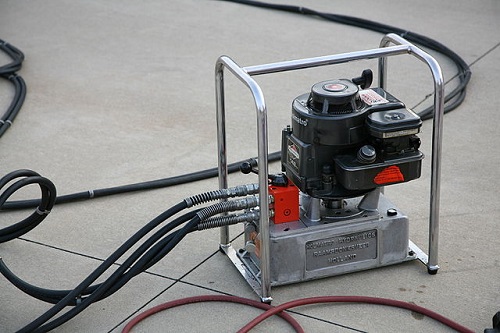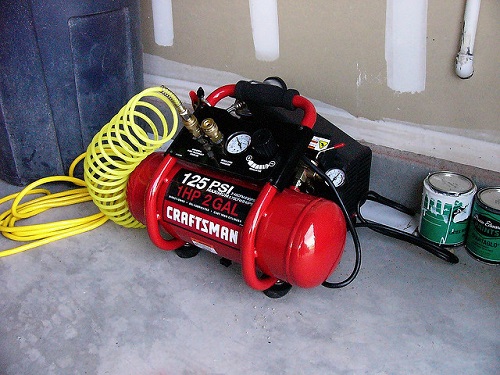Difference Between Pump and Compressor
Fluidic transmission systems include generators (pumps or compressors), fluid motors and control elements in the circular flow in which the working fluid transmits energy by circulating. The pumps are machines in which externally brought mechanical energy (operation of the drive machine) is transformed into working fluid energy. In compressors, on the other side, the mechanical energy is converted into energy of compressed air.
What is Pump?
Pumps are hydraulic machines that transfer mechanical energy from the engine to the fluid flowing through it. Pumps are used to transport fluids that are practically incompressible, which can be pure or mixed with solid materials, with different density and temperature, chemically neutral or aggressive, and so on. Depending on the connection, often the same machine can work as a pump or engine (such a machine is said to be reversible, but reversibility can also mean that there is only the possibility of rotation in both directions).
Electric motors are commonly used for pump operation, and internal combustion engines in case of mobile hydraulics. Pumps are divided into two basic categories: positive displacement pumps and centrifugal pumps (such as turbopumps). Positive displacement pumps transport the fluid (increase of pressure and flow) by reducing the volume of the chamber in the pump, and are used for relatively small flows at relatively high supply altitudes. Turbopumps give power to the fluid in the rotor so that the mobile blades provide pressure force to the fluid. They are used for relatively large flows and low supply levels, so they are not generally used in hydraulics. Positive displacement pumps include: piston pumps (lift, force pump), rotary pumps (coil, gear or wing pump) and diaphragm pump. The basic operating parameters for pumps are: flow rate (volume flow – m3/s or mass flow – kg/s), specific work (J/kg), power (W), efficiency (%).
What is Compressor?
Compressors and pneumatic motors in principle do not differ and structurally are different only in details. For example, if the piston engine or compressor cylinder is filled and discharged through suction and exhaust valves, the engine must have a forced opening/closing mechanism (camshaft), while in case of a compressor the valve can be started automatically (with the air pressure in the cylinder) . Often, the same machine can operate as a compressor or motor, depending on the installation or connection to the system. The basic division of compressors is into positive displacement compressors and turbochargers. The first type is almost exclusively used in pneumatics. Their principle of work is based on a variable volume operating chamber (e.g. cylinder with piston). Reducing the volume of the operating chamber reduces the volume of air in it, causing a corresponding increase in air pressure. They are divided into rotary (lobe, screw, scroll, vane and liquid ring compressor) and reciprocating (diaphragm, single and double acting compressor). The dynamic ones are further separated into centrifugal and axial.
Difference Between Pump and Compressor
1. Operating principle of Pump and Compressor
In case of a pump the fluid (either liquid or gas) is moved from one place to another. A compressor squeezes the volume of a gas and (commonly) pumps it elsewhere. While pumps can use liquids or gases, compressors for the most part work only with gas. That is because liquids are extremely hard to compress.
2. Structure of Pump and Compressor
It is very difficult to explain the structural differences between pumps and compressors – especially as there are also tremendous differences within the groups. Both are classified depending on the principles of work, application, fluids used, construction and so on. Basic parts of a pump are the housing (casing), impeller, motor, shaft and volute. Soma basic components of compressors are : motor, storage tank, drain, intake filter, valves and so on.
3. Application of Pump and Compressor
Pumps and compressors are amongst the most commonly used machines. They are applied in different technological constructions, both in factories and larger plants, as well as in almost every household. The most commonly used domestic pumps are in the washing machines where they serve to drain the water out of the appliance in the sewerage system. Cars, ships, airplanes also have pumps. These are cooling, oil, fuel, servo device pumps etc. A large number of industrial plants have pumps with that serve various purposes – irrigation pumps, mining pumps, air conditioning, refrigeration etc. Compressors are also often applied in the refrigeration technology (refrigerators, showcases, air conditioners). They also have application in the processing industry: breweries (CO2), refineries, technical gas plants (O2, N2 bottles); in pneumatic tools and automatics: shipbuilding, construction, vehicles (brakes, doors …); and so on.
Pump vs. Compressor : Comparison Table
| Pump | Compressor |
| Increase the kinetic energy of the fluid which further increases the pressure energy | Increase the potential energy by pressuring in smaller volume |
| Fluid can be liquid or gas | Uses only gas |
| The volume form inlet to outlet is not changed | There is a volume change |
| There is not necessarily a pressure change | There must be a pressure change |
| No storage | Has storage capacity |
| Cheaper | More expensive |
Summary of Pump and Compressor
- Pump is a hydraulic machine that alters a fluids’ energy, which flows through the machine. In the literature, pumps are divided into dynamic and positive displacement pumps, where dynamic are defined as pumps in which the liquid is transmitted by the action of forces that are acting on them in a space that is continuously connected to the suction and pressure pipelines of the pump. In case of positive displacement pumps liquids are transmitted by periodic changes in the volume of space occupied by the liquid, which occasionally is alternated between the suction and pressure pipelines of the pump.
- Compressor is a machine or compression device for air or gas. By compressing air or gas, a heat is generated and temperature rises, which means that the used mechanical energy (drive machine) is used to compress and partly to increase the temperature (internal energy) of the compressed air or gas.
- Pumps and compressors have great applications in industry, mining, construction, metallurgy, process industry (brewers (CO2), refineries), refrigeration (refrigerators, air conditioners etc.)
- Difference Between Thermodynamics and Kinetics - June 24, 2018
- Difference Between Welding and Soldering - June 24, 2018
- Difference Between Additive Colors and Subtractive Colors - June 20, 2018
Search DifferenceBetween.net :
Leave a Response
References :
[0]Barber, A. “Pneumatic Handbook”. 8th Edition. Kidlington, Oxford: Elsevier Science &Technology Books, 1997
[1]Incropera, F. P. and DeWitt, D. P. “Introduction to Heat Transfer”. 4th Edition. Hoboken, NJ: John Wiley & Sons, Inc., 2001
[2]Threlkeld, J. L. “Thermal Environmental Engineering”. Englewood Cliffs, NJ: Prentice-Hall, Inc., 1970
[3]"Image Credit: https://commons.wikimedia.org/wiki/File:Extrication_hydraulic_pump.jpg"
[4]"Image Credit: https://www.flickr.com/photos/hackaday/1783495516"


